
|
|
|
|
|
|
|
|
|
|
Everybody smokes. RuPaul is queen. High culture is Robert Wagner and Stephanie Powers in A.R. Gurney's Love Letters. Boxing is considered a sport. There are slot machines in the K-Mart.
It must be Las Vegas.
During COMDEX, the city holds two utterly immiscible populations: '90s types who came for the convention, and '50s throwbacks who think of Las Vegas as a classy holiday destination. One group throws its money away buying the latest technology every six months; the other flushes its cash down the toilet 25 cents at a time.
A travel guide for Spring COMDEX might come from Fodor's or Gault-Millau; the official guide to Fall COMDEX is Hunter Thompson's Fear and Loathing in Las Vegas. Spring is Southern hospitality; Fall is polyester-clad sharpies taking a long, lustful look at your wallet.
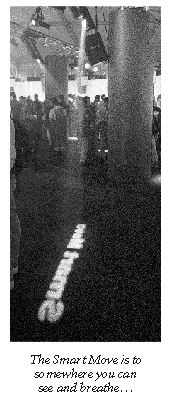 Professional skeptics like me often describe product demos
as "done with smoke and mirrors." Well, for the first time
in my memory, a COMDEX vendor had the chutzpah to build a custom booth
that featured both actual smoke and real mirrors.
Professional skeptics like me often describe product demos
as "done with smoke and mirrors." Well, for the first time
in my memory, a COMDEX vendor had the chutzpah to build a custom booth
that featured both actual smoke and real mirrors.Outside the Las Vegas Convention Center, IBM and Motorola erected a huge free-standing pavilion to promote the PowerPC processor. Inside was a large sound-and-light-show area surrounded by small vendor booths. To jazz up the booth area, the pavilion's designers installed smoke machines and fancy programmable light projectors, which used moving mirrors to create dazzling pictures and beams of light.
The result was an information-age disco full of coughing, disoriented people. Colorful PowerPC logos blazed across the floor, walls, computer screens, and directly into the dilated eyes of reeling punters. The confusing layout and narrow walkways left more than one visitor spinning around asking, "Do you know how to get out?"
Careful study of the pavilion left me with the impression that there wasn't a heck of a lot beneath the sensory overload. With one major exception, the Apple PowerMac series, the PowerPC doesn't even qualify as a fringe platform. The non-Mac applications being demonstrated in the pavilion were mostly either Windows programs running (slowly) on NT for PowerPC or vertical-market custom software.
There was considerable confusion over what would constitute the actual PowerPC platform of the future. IBM's dream of a new, open, modular reference platform collided with the reality that the vast majority of PowerPC chips being sold are built into totally proprietary PowerMacs.
To me, the most telling sign of the PowerPC consortium's weakness was the lack of a major Microsoft presence. The software giant had only two tiny one-man booths showing Word for NT and the like running on NT for PowerPC. Knowing how hard Microsoft goes after any market that it feels might be profitable, even in the distant future, what does that say about PowerPC? Either IBM or Microsoft must be misjudging the potential size of the PowerPC market; if you were a software developer, whom would you gamble is right?
There were a few other booths whose motto was, "Pay no attention to the man behind that curtain!" Taligent, the Motorola-IBM-HP-Apple partnership, had a booth with real literature and even a few demo systems. Unfortunately, nobody seemed to know what Taligent is, other than an "object-oriented operating environment." How whatever that is will help users do anything other than use up lots of disk space and CPU cycles is unclear. Taligent appears to provide no support for any existing software, but of course everybody will rewrite their applications for a whole new operating system, just as they did for OS/2 Presentation Manager.
If Apple's Newton people bothered to show up, they certainly weren't where they were supposed to be. On the whole, the Personal Digital Assistant market was so quiet it might easily have been mistaken for a morgue.
In the "Oh, really?" category was Asymetrix, which billed itself as "The Leader in Windows Multimedia." Also disturbing was Digital's booth, where hapless presenters were still playing baseball in a year marked by a sordid greed-driven baseball strike. I am beginning to think that Digital might need either a new PR firm or an exorcist.
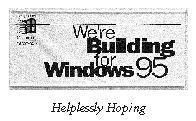 Each passing COMDEX marks another step in Microsoft's
march toward world domination. The company's apparent goal: "if
it uses electricity, we want part of it." Two of the beast's tentacles,
Plug and Play and MS at Work, showed particularly strong growth.
Each passing COMDEX marks another step in Microsoft's
march toward world domination. The company's apparent goal: "if
it uses electricity, we want part of it." Two of the beast's tentacles,
Plug and Play and MS at Work, showed particularly strong growth.MS at Work is a standard designed to provide connectivity between PCs and office equipment, at least initially. Someday, your toaster may support the standard, with your PC clicking its electronic tongue over that non-organic bread. HP was showing its OfficeJet scanner-fax-printer combination, the sort of integrated MS at Work-enabled office device we are likely to see more and more of. Other vendors were demonstrating systems that use at Work's Telephony API to provide integration between your desktop PC and your office phone system.
Plug and Play is the technology that is supposed to give PC users the sort of plug-it-in-and-go adapter cards that Mac users have (at least theoretically) enjoyed for years. Plug and Play is one of the major components of the next version of Windows. Several vendors were showing Plug and Play-compatible cards, including Adaptec, maker of many SCSI products.
There were also impressive demonstrations of hot-swapping technology, an offshoot of the Plug and Play standard. For the first time, I saw a laptop gracefully handle a PCMCIA device swap (in this case removing a modem and inserting a hard disk) without a shutdown or reboot.
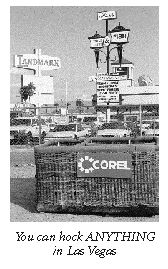 Microsoft remains as intent as ever on cannibalizing other people's
markets. The Microsoft booth featured plenty of literature on tools
to help you migrate from NetWare to NT Advanced Server. Coupled with
Microsoft's attractive LAN licensing prices, it was as naked a threat
to Novell as I've seen in a long time.
Microsoft remains as intent as ever on cannibalizing other people's
markets. The Microsoft booth featured plenty of literature on tools
to help you migrate from NetWare to NT Advanced Server. Coupled with
Microsoft's attractive LAN licensing prices, it was as naked a threat
to Novell as I've seen in a long time.
This probably helps explain Novell's new, Microsoft-friendly attitude. Suddenly, the two arch-enemies are good friends, at least in the trade press. I'd rather make nice with a crocodile.
Novell is soldiering gamely on, though; the new NetWare 4.1 makes an effort (some would say for the first time) to actually address customer concerns. Even better, Novell has considerably lowered its prices.
Microsoft is also going after the last mainframe users. It has announced a series of products, dubbed "Microsoft Back Office," designed to subvert the few corporate IS departments that haven't already been subsumed by the downsizing bug. SNA Server, for example, allows a PC running NT to bridge between the IBM Systems Network Architecture used by big iron and the IPX and TCP/IP protocols used by PC LANs.
Microsoft did make one highly visible misstep: it launched a truly annoying "cryptic messages in black type on a white background" ad campaign. Las Vegas was littered with advertising asking things like, "Where do you want to go today?" Hopefully somewhere Microsoft's flacks can't find me...
Speaking of Microsoft advertising, many software vendors had big pennants claiming they were "building for Windows '95." If that isn't optimism, I don't know. There was a definite air of frustration whenever the topic of Microsoft's Heisenberg-principle release date for the new Windows came up.
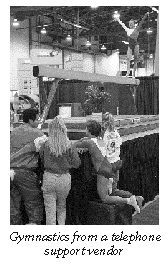 Though they were buried under a ton of chaff, there were
quite a few worthwhile things to see at COMDEX:
Though they were buried under a ton of chaff, there were
quite a few worthwhile things to see at COMDEX:
The PowerMacs changed all that. Though there have been problems, the transition from 680x0 processors to the PowerPC chip has gone amazingly smoothly, especially considering the drastic nature of the change. There was a genuine sense of vitality in the Mac-related booths at COMDEX. No one believes that Apple is about to take over the personal computer market, but its ten percent market share seems secure, and who knows what might happen?
It's interesting to note that Apple has been edging away from emphasizing how different Macs are from PCs. Literature at the show pointed out how compatible the Mac is with PCs, not how "insanely great" the Mac inherently is.
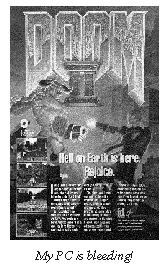 Enough of these New Age Myst clones and talking books
for kids! We want multimedia mayhem! Doom is a game with only one
rule: kill anything that moves. Slap some lead upside his head!
Enough of these New Age Myst clones and talking books
for kids! We want multimedia mayhem! Doom is a game with only one
rule: kill anything that moves. Slap some lead upside his head!Both Doom I and Doom II were everywhere at COMDEX, especially the highly-amplified booths in the multimedia pavilion at the Sands Convention Center. For fun untainted by thinking, writing things down, reading narration, and listening to spacey music, Doom can't be beat. Even though it's a lowly DOS application, Doom provides good graphics (lots of red) and excellent sound. I'm partial to the chainsaw myself.
More generally, vendors now seem to agree that multimedia will never really have a place in mainstream business, except for one-per-site tools like video conferencing and multilocation "white boards." Multimedia vendors are concentrating their efforts where they probably should have all along: games. PCs are now beginning to be viable replacements for home video game systems: they have far more storage and processing power, and there are more computers in homes than ever before. Multimedia PCs and Macs are becoming downright cheap.
To help along this trend, Microsoft has introduced a new set of APIs for Windows called "WinG" for Windows Games Interface. This set of system calls allows game designers a standardized way to carry out specialized operations (like direct frame writes) needed for responsive game performance. WinG will make it possible for Windows to support sophisticated arcade and adventure games like never before.
Multimedia vendors are making considerable strides toward practical full-motion full-screen video. Though not quite there yet, the technology (especially MPEG and MPEG-2 in hardware) may be good enough to be really useful by Spring COMDEX. Intergraph, a vendor of high-end imaging PCs, was demonstrating several breathtaking full-screen digital-video applications running on dual-Pentium systems. One of them, an interactive drive through the country, was outstanding.
New 128-bit video cards, like those being shown by Number Nine, should speed the video race. It seems like only yesterday that 64-bit technology was state of the art.
Useful virtual reality, though, continues to seem fairly far away. The headsets are awkward and the software is still crude.
It's really the power supply's job to generate any voltages that your system may need. New supplies from companies like PC Power & Cooling are available with 3.3V outputs to provide that pricey Pentium CPU with clean power.
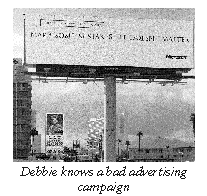 There were a number of trends at COMDEX that may or may
not bode well for the industry. For most of them, it's too early to
tell whether they're meaningful or just hype.
There were a number of trends at COMDEX that may or may
not bode well for the industry. For most of them, it's too early to
tell whether they're meaningful or just hype.
The Net has already become less fun since legions of new commercial users have gotten access: everything is slower, and every day more people trample the unspoken rules that once kept things at least minimally civilized. With no central authority running the Net, there is no one to impose order on chaos. I can foresee a future where the Internet dies of overuse and undercivility.
 Ideally, when used with properly-designed applications, adding a second
CPU should provide about 1.7 times the performance of a single processor.
However, it hasn't turned out to be that simple. A flaw in the Pentium
prevents the dual-processor configuration from working properly when
the chip's internal write-back cache is enabled. To permit multiprocessing,
the cache must be configured in write-through mode, which drastically
slows down the CPU.
Ideally, when used with properly-designed applications, adding a second
CPU should provide about 1.7 times the performance of a single processor.
However, it hasn't turned out to be that simple. A flaw in the Pentium
prevents the dual-processor configuration from working properly when
the chip's internal write-back cache is enabled. To permit multiprocessing,
the cache must be configured in write-through mode, which drastically
slows down the CPU.
In some cases, adding a second CPU has caused a 30 percent slowdown in the operation of single-threaded applications (such as virtually all existing Windows programs). Interestingly, Windows NT works properly on dual-processor systems with the flawed CPU, which means that NT's designers knew about the problem and constructed their hardware drivers to switch the CPU cache into write-through mode. Yet it took end-user discoveries to bring the problem out into the light of day.
Intel has promised a fix for the problem in future runs, and some 100MHz Pentiums apparently already have the correct cache logic. Once the dual-processor designs settle down, we will probably begin to see sanely-priced systems with four, eight, or even more CPUs, if there's anyone out there who really needs that kind of power, literally a mainframe on your desktop. The only hurdle is that systems with more than two CPUs really need to have a separate Level 2 (external) cache for each processor, which will keep prices from dropping too much; Level 2 caches need expensive and power-hungry Static RAM.
In computing as in most other walks of life, an original idea never goes unnoticed. Among the things that would have been clever if they had been done by one vendor instead of a dozen: